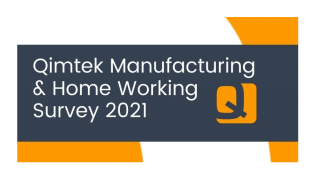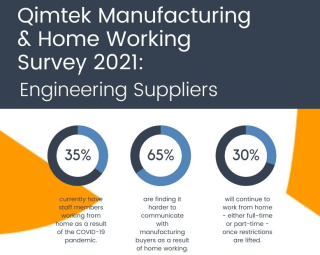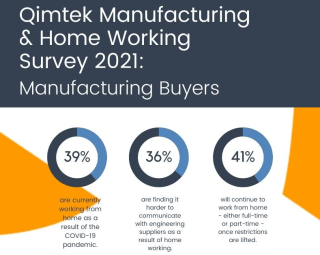
Over the past eighteen months, the business landscape has changed dramatically as a result of the COVID-19 pandemic. Companies spanning all industries have had to adapt to the ensuing restrictions, meaning that day-to-day operation, communication and collaboration has completely transformed as a result.
One of the overarching features of the 'new normal' is home working, as many businesses were unable to facilitate the use of physical premises during lockdown. However, due to the fact that employees of manufacturing and engineering businesses typically have to be physically present in order to complete their jobs, how widespread has home working become within our sector? Additionally, is home working here to stay, or has it simply been used as a means to overcoming the difficulties imposed by the national restrictions?
In May 2021, Qimtek conducted a survey amongst buyers and suppliers within our network to shed some light on the prevalence of home working within the engineering and manufacturing industry. Read on to find out more about our findings.
The Prevalence of Home Working Within Engineering & Manufacturing:

The level of home working was found to be very similar across buying and supplying organisations. 35% of engineering suppliers who participated in the survey reported that they currently have staff members who are working from home as a result of the COVID-19 pandemic; meanwhile, home working was found to be slightly higher amongst manufacturing buyers, with 39% currently working from home either full or part time.
Home working amongst subcontract engineering companies is more than likely reserved for administrative and sales staff.
The ability to work from home is ultimately dictated by the nature of the job role, meaning that it's possibly expected that home working is more prevalent amongst purchasers, who generally tend to be much more desk-based than engineering suppliers. Meanwhile, home working amongst subcontract engineering companies is more than likely reserved for administrative and sales staff.
These figures are actually more or less in line with the national average, with 36.5% of the population reporting that they were working from home in a 2020 study. Although our survey didn't take location and job role into account, the aforementioned 2020 report cited huge variations in home working prevalence in accordance with these factors, being most common amongst people in professional occupations who are situated in London.
The Effects of Home Working:
Home working has changed many of the ways we communicate and collaborate, with email becoming the preferred method of contact for a lot of people. However, this shift hasn't necessarily spelled good news for efficiency of communication and has left many people finding it more difficult to reach both colleagues and customers.
There was a lot of disparity between the results given by engineering suppliers and manufacturing buyers.
This was most evident amongst engineering suppliers, who overwhelmingly reported difficulties in communication as a result of the restrictions. 65% of engineering suppliers interviewed stated that they found it harder to contact manufacturing buyers, with only 26% reporting that communication had remained unaffected. On the other hand, 9% of engineering suppliers reported that they were actually finding it easier to communicate with buyers due to home working.
However, there was a lot of disparity between the results given by engineering suppliers and manufacturing buyers. In contrast to engineering suppliers, a majority of manufacturing buyers reported that communication had not been affected by the restrictions (62%), signalling that current contact is perhaps initiated at purchasers' convenience. Meanwhile, just over a third of buyers echoed the sentiments of engineering suppliers, stating that communication had become more difficult due to home working (36%), with just 2.6% of manufacturing purchasers reporting that they were finding it easier to communicate with suppliers under the restrictions.
Is Home Working Here to Stay?

As a result of the COVID-19 pandemic, many businesses have foregone physical premises in favour of full-time home working. Although the very nature of engineering and manufacturing precludes such businesses from following suit entirely, many have been left to wonder whether a degree of home working will prevail once the current restrictions have ended.
The manufacturing industry can expect more of a degree of flexibility surrounding working from home.
The results of our report certainly indicate that the manufacturing industry can expect more of a degree of flexibility surrounding working from home, although this may not be as pronounced as in other sectors. Amongst the engineering suppliers we surveyed, 4% said that they had staff who would continue to work from home full-time, whilst 26% reported that at least some of their staff members would be splitting their time between home and the office moving forward. Nonetheless, 70% confirmed that all staff members would be returning to the office on a full-time basis once restrictions end.
The rates of prolonged home working amongst manufacturing buyers sat slightly higher than those of engineering suppliers, although a majority are still planning to work from the office full-time once they are able (59%). Meanwhile, 8% confirmed that they would be working from home on a permanent basis, whilst 33% expect to continue home working part-time.
Amongst both manufacturing buyers and engineering suppliers, the results indicate that most of the people who are currently working from home are planning to continue doing so - at least to some extent - on a long-term basis.
Long-Term Implications:
The COVID-19 pandemic has irreversibly changed the working environment for many people, meaning that a certain degree of acceptance needs to be employed if we are to make the new conditions work universally. Whilst communication will undoubtedly be impacted to an extent, ease of contact should hopefully be restored somewhat once more people return to offices and factories. It's also safe to assume that further contingencies will be put in place to allow those working from home to become more contactable.
In the meantime, it's important that we overcome these setbacks to enable easier communication on both sides. The engineering and manufacturing industries are already battling a myriad of challenges in the form of the materials shortage and the ramifications of Brexit, meaning that effective communication is now more important than ever before.
Indeed, if we do not make an effort to keep in touch with our clients and suppliers, then it is only our own businesses and our own subcontract projects that will suffer as a result
